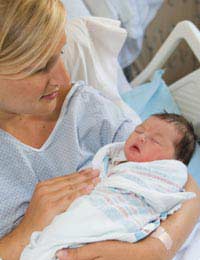Postpartum Fecal Incontinence

Postpartum fecal incontinence, or the inability to control bowel movements or wind after giving birth, can be embarrassing but is by no means happening only to you. While not as common as postpartum urinary incontinence, postpartum fecal incontinence is recognised as condition that can be associated with giving birth and therefore there is no reason not to seek help for this matter. In fact, some studies put the number of women who experience postpartum fecal incontinence as high as 25% of those who give birth vaginally or via cesarean section. Understanding the causes of postpartum fecal incontinence, how to deal with it and when you can expect it to end should help you cope better with this condition.
Understanding Postpartum Fecal Incontinence
There are many reasons fecal incontinence may occur after giving birth. Weakening of the pelvic floor muscles, injury or damage to associated nerves and injury to the anal sphincter are the most common contributing factors to postpartum fecal incontinence. The factors may be present following vaginal or c-section births, and serious tears or an episiotomy (surgical incision in the perineum) are known to be associated with loose bowel movements or wind. Births requiring the assistance of forceps are also more likely to contribute to postpartum fecal incontinence.Dealing With Postpartum Fecal Incontinence
There is nothing pretty about postpartum fecal incontinence, and the idea of having an embarrassing accident may be more than enough to keep you in the safety of your own home for a long time. Don’t let this condition keep you from your life. There are special absorbent pads you can use to deal with any accidents, and you can strengthen your pelvic floor muscles with Kegel exercises (contracting and relaxing them as you would to stop the flow of urine) which may help limit fecal incontinence. As an associated benefit, Kegels also help direct blood to the perineal area which may help heal a tear or incision as well. Avoiding foods which are known to produce wind (beans, bran, cabbage, etc), or are hard for you to digest should help you produce less wind and stools as well. Talking with a medical professional should also help you better understand the particulars of your postpartum fecal incontinence.Ending Postpartum Fecal Incontinence
Postpartum fecal incontinence tends to correct itself by about six months after giving birth, once the body has had a chance to regain strength and heal itself. Recovery may be speeded by doing Kegel exercises. Sometimes fecal incontinence will last longer than six months, or will start up again after ceasing. If you experience extended or new fecal incontinence consult a medical professional who will help you determine if you require further treatment such as intensive pelvic floor muscle therapy, biofeedback or some form of surgery.Postpartum fecal incontinence may affect as many as 1 in every 4 women who give birth, but this embarrassing condition is not often discussed. Understanding why fecal incontinence occurs after pregnancy and birth, how to deal with it if you do experience, and when you can expect it to end should help you better cope with postpartum fecal incontinence.
- Embarrassing Emotions During Pregnancy
- Leaking Breasts During and After Pregnancy
- Your Sex Life During Pregnancy
- Cloasma or Melasma: Skin Darkening During Pregnancy
- Vaginal Discharge and Odour
- Coping With Morning Sickness in Public
- Breast Feeding in Public
- What to Do If Your Waters Break in Public
- Resuming a Normal Sex Life After a Baby
- After-Pains Following Delivery
- Bleeding After Giving Birth
- Pregnancy Related Stretch Marks


Re: Talking to an Elderly Person About Hygiene
My mom is 95. I had a talk with her about having someone come in and do light housekeeping, wash her bed sheets…
Re: Adult Bed Wetting
I am 57 and still wet the bed most nights.
Re: Verrucas
I'm 13 in about 6 days I've had verrucas since I was 8-9, it's so embarrassing because I have to get changed in a group for PE I have one on the outside of…
Re: Hairy Toes & Feet
So funny how bigots of both signs say the opposite, that the shaved man aesthetics is influenced by gays, now some gay people say it's…
Re: Inverted Nipples
Hi im 13 and yesterday i realised i have inverted nipples but i had a surgery near my heart when i was four months old and i just want to not have…
Re: Adult Bed Wetting
i have been a bedwetter for so long now i am used to it and sleep in a single bed next to my wife
Re: Adult Bed Wetting
Hi im 52 the last 6 months ive started to.wet the bed. It can happen 2 or more times a week . I went to bed at 2am i woke up at 5am needing to…
Re: Unsightly Warts on the Face and Neck
Ihello I have face warts many years and Neck ,pls help
Re: Adult Bed Wetting
i was a bedwetter as a child until 15 due to molestation a few times growing up.. then went in hospital age 18 and wet the bed whilst staying…
Re: Inverted Nipples
Blb - Your Question:Hi I’ve recently had my baby and ever since Then I have one inverted nipple not breastfed should I be concerned?